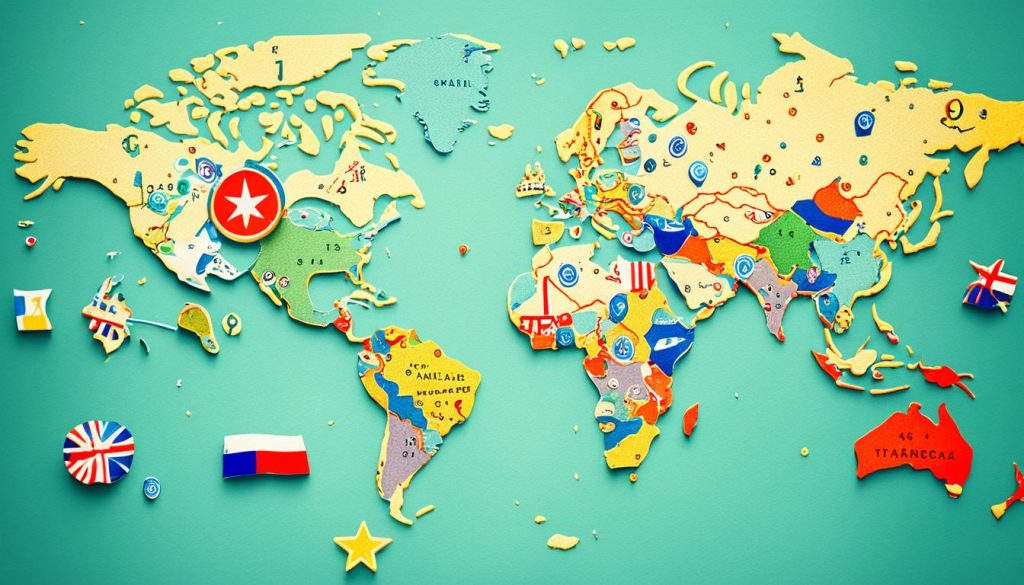Entering new markets often comes with high localisation costs, making it hard to enter these areas. Companies need to tweak their products and services to meet local demands when they move into a new area. This effort, called market-specific adaptations, means changing how things are marketed to fit with what locals like, their laws, and culture.
While tailoring products helps in connecting with the people there, it increases costs related to making, following laws, and distributing things. For example, a beer company might have to sell non-alcoholic drinks in places where alcohol isn’t allowed. Hence, companies need to weigh many things, like how they can make things, what the law says, and the economy, to pick the best route.
Key Takeaways
- Localisation expenses are a major consideration for companies entering new markets.
- Market-specific adaptations involve modifying the marketing mix to align with local preferences and regulations.
- Examples include introducing non-alcoholic beer options in regions where alcohol consumption is restricted.
- Adaptation strategies can significantly enhance local market engagement.
- Internal and external factors play crucial roles in deciding between standardisation and localisation.
Introduction to Market-Specific Adaptations

Market-specific adaptations are strategies businesses use to either stick to a global approach or adjust their methods to meet local needs. This decision helps companies find the right balance between appealing to everyone and respecting local preferences. It ensures they keep their brand’s identity while meeting different customer needs.
Companies use market segmentation to understand what local customers want. By doing this, they can make their products fit better with local tastes. This not only pleases customers but also follows local laws, showing how important it is to adapt carefully.
Choosing to make market-specific adaptations allows businesses to cater to the varied tastes of customers in different places. It’s about making sure products fit with local cultures, preferences, and even the competitive environment. These steps are key to making adaptations work.
However, adapting can lead to higher costs and the challenge of designing marketing strategies for each locale. That’s why it’s crucial to use market segmentation and thoughtful planning. This way, businesses can succeed in balancing global and local demands.
Factors Contributing to Higher Costs in Localisation

Making sure your product fits well in different markets is key. But, adapting it for each market can get pricey because of the need for specific changes.
Cultural Adaptation
Cultural adaptation is one big reason for higher costs. It means changing your products and how you promote them to match local ways and likes. For example, you might have to change how something looks, its name, and the way you talk about it. Doing this well means really understanding the culture, which takes a lot of time and money. The cost goes up when you need unique content that speaks directly to each market.
Regulatory Compliance
Regulatory compliance also adds to the expense. Your products must fit the rules of each place you sell them. Sometimes, this means changing what’s in them, how they’re packaged, or how they’re sold. Getting the right legal advice, certifications, and making these changes can cost a lot. All these steps mean spending more to adapt to each market, a tough balance for maintaining efficiency while meeting local needs.
High Costs of Geographic Tailoring

Businesses need geographic tailoring to succeed in various markets. But, localisation can be expensive. It mainly costs more because of changes to infrastructure and distribution.
Changing a product for different areas can need a lot of money. Making these changes to fit local rules and ways of doing things adds to the cost.
Infrastructure and Distribution
For effective geographic tailoring, companies must change their supply chain. They need to work with local distribution and fit into the area’s transport and tech systems. These changes add to the company’s everyday costs.ob,” takes work. It means making or improving facilities and matching local distribution tastes. Keeping these costs under control is key for businesses wanting to adapt yet stay smart about spending.
Impact of Regional Customisation on Pricing Strategies
Adapting products or services for different regions affects pricing due to changes in production costs. These changes are because of the need to match local tastes, customs, and laws. This leads to varying costs for materials, labour, and other expenses.
Several factors play a part in these pricing changes. One reason is the need to buy local materials, which might cost more or less than expected. Also, what we pay for labour can change based on what is usual in the area, affecting product prices.
Then, there are additional costs like taxes, tariffs, and the expense of getting goods to where they need to be. These extra costs can make the end price higher for customers. To stay competitive, prices have to reflect these costs without scaring away buyers.
- Variable costs of local materials
- Changes in labour expenses based on local wages
- Increased overhead costs including taxes, tariffs, and transportation
In conclusion, pricing strategies must be carefully thought out when adapting products for different regions. It’s all about balancing the added costs of localisation to keep prices appealing to customers in the area.
Higher Costs Due to Market-Specific Adaptations

When a business modifies its products for different markets, the costs go up due to market-specific adaptations. These extra costs come mainly from the need for regional customization. Getting to know what local customers want also requires a big spend.
Entering various markets brings about hefty localization expenses as well. Companies must translate their content and tweak their marketing. They also need to follow local laws closely. All these adjustments can be expensive, challenging even big companies.
Creating marketing campaigns that fit local markets also pushes up the higher costs due to market-specific adaptations. To be effective, companies have to understand the local culture and buying patterns. But these tailored adverts can help win customers and build loyalty.
Then, there’s the money spent on following local laws, adding to localization expenses. Every new market has its own set of rules that businesses must comply with. This legal side of things means companies have to invest more money.
Although these adaptations can be costly at first, they can pay off in the long run. Spending more initially on market-specific adaptations can lead to a larger market share. Over time, companies can win loyal customers in many places. This shows the value of adapting to regional needs.
Balancing Global and Local Marketing Strategies
In our globally linked world, it’s key for companies to blend international and local marketing well. They must find a sweet spot between keeping a single brand identity and adapting to different cultures. By doing this, they can use resources efficiently and still meet unique local needs.
Breaking down the market is critical in this mix. By identifying groups based on location, habits, or demographics, companies can focus their marketing better. But, they must weigh the pros and cons of adapting or keeping things uniform. Adapting to local norms can help a company fit in better and build loyalty, though it can be costly.
A mix of global and local is often the best path. This means keeping the brand’s core values but tweaking aspects to appeal locally. A big company, for example, might keep its main logo but change ads to reflect local cultures. With careful market segmentation, companies can reach more people while managing the challenges of cultural differences.











